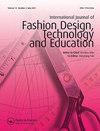The decision to sew: making face masks during the COVID-19 pandemic
IF 2.2
Q3 BUSINESS
International Journal of Fashion Design, Technology and Education
Pub Date : 2022-03-02
DOI:10.1080/17543266.2022.2043944
引用次数: 2
Abstract
ABSTRACT The COVID-19 pandemic provides an opportunity to understand the motivations of individuals who sew face masks. This study uses an expanded Theory of Planned Behavior (TPB) model with data (n = 144) from a nationwide (United States) survey in late 2020. Data were analyzed with exploratory and confirmatory factor analysis, structural equation modelling, and multi-group comparison. Results indicated intention to sew face masks was predicted by subjective norm, perceived behaviour control, health consciousness, and fashion innovativeness. Making intention positively influenced individuals’ actual mask sewing behaviour. The relationship between making intention and actual behaviour is moderated by employment status and age.缝制的决定:在COVID-19大流行期间制作口罩
2019冠状病毒病大流行为了解缝制口罩的个人动机提供了机会。本研究使用了扩展的计划行为理论(TPB)模型,其数据(n = 144)来自2020年底的一项全国性(美国)调查。数据分析采用探索性和验证性因子分析、结构方程模型和多组比较。结果表明,主观规范、感知行为控制、健康意识和时尚创新是缝制口罩意愿的预测因素。制作意图正向影响个体的实际面具缝制行为。制定意图与实际行为之间的关系受就业状况和年龄的调节。
本文章由计算机程序翻译,如有差异,请以英文原文为准。
求助全文
约1分钟内获得全文
求助全文
来源期刊

International Journal of Fashion Design, Technology and Education
Arts and Humanities-Visual Arts and Performing Arts
CiteScore
3.10
自引率
0.00%
发文量
36
 求助内容:
求助内容: 应助结果提醒方式:
应助结果提醒方式:


